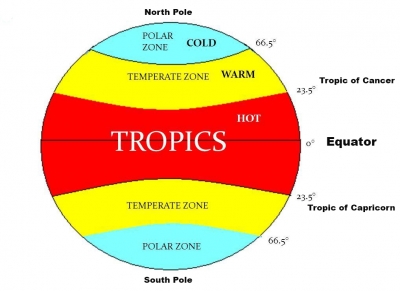
The climate of an area is the type of weather it usually experiences. It includes the amount of rainfall, hours of sunshine, and highest, lowest, and average temperatures. Earth is divided into climate zones that are based on their distance from the equator.
Tropical zone:
This area is very hot and damp all year round. It rains a lot and thunderstorms are common. Nevertheless, this belt still receives considerable sunshine, and with the excessive rainfall, provides ideal growing conditions for luxuriant vegetation. The principal regions with a tropical climate are the Amazon Basin in Brazil, the Congo Basin in West Africa and Indonesia.
Because a substantial part of the Sun’s heat is used up in evaporation and rain formation, temperatures in the tropics rarely exceed 35°C; a daytime maximum of 32°C is more common. At night the abundant cloud cover restricts heat loss, and minimum temperatures fall no lower than about 22°C. This high level of temperature is maintained with little variation throughout the year. The seasons, so far as they do exist, are distinguished not as warm and cold periods but by variation of rainfall and cloudiness. Greatest rainfall occurs when the Sun at midday is overhead. On the equator this occurs twice a year in March and September, and consequently there are two wet and two dry seasons. Further away from the equator, the two rainy seasons merge into one, and the climate becomes more monsoonal, with one wet season and one dry season. In the Northern Hemisphere, the wet season occurs from May to July, in the Southern Hemisphere from November to February.
Subtropical zone:
Here, summers are long, dry, and hot. Winters are wet, but usually short and mild. In general, the mean temperature year round is above 20 °C (68 °F), the coldest month of the year has a temperature below this mark. Mediterranean climates are considered subtropical. Different subtropical areas have different types of plants. Humid subtropical areas have evergreen and deciduous trees, Mediterranean areas have scrub, and deserts have cacti.
Temperate zone:
Extreme conditions are rare here. Summers are warm and winters cold, but not freezing. The changes between summer and winter are generally invigorating without being frustratingly extreme. There are two types of temperate climate: maritime and continental. The maritime climate is strongly influenced by the oceans, which maintain fairly steady temperatures across the seasons. Since the prevailing winds are westerly in the temperate zones, the western edge of continents in these areas experiences most commonly the maritime climate. Such regions include Western Europe, in particular the UK and western North America at latitudes between 40 and 60° north.
Polar zone:
It is icy and dry all year round here. Winters are long round dark, while in summer the Sun shines most of the time. During the long polar nights, which last six months at the poles, temperatures can fall to extremely low values. The lowest temperature ever recorded occurred in Antarctica, where a value of -88 degree Celsius was reported.
The North Polar Region includes the ice-covered Arctic Ocean, the Greenland continent and much of Northern Canada and Northern Siberia. In the Southern Hemisphere, the vast mountainous continent of Antarctic is covered by snow and compacted ice several kilometres thick.
Polar climates tend to be dry because the descending air is cold and lacks significant moisture, precluding the formation of clouds and snowfall. Some polar regions receive less than 10 inches or 250 millimetres of precipitation each year, and can be as dry as the hot deserts of the subtropical climate zone. The continental ice sheets of Greenland and Antarctica have taken many millions of years to form.
Picture Credit : Google




